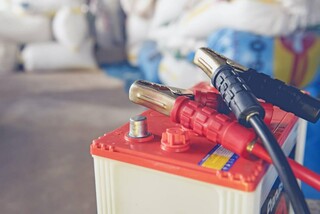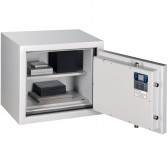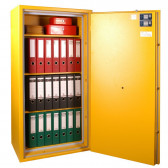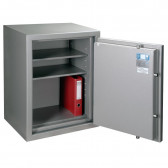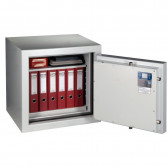Lithium-ion and other rechargeable energy batteries are used as components in everyday products: electric cars, electric bikes, drones, mobile phones, laptops, digital cameras, toothbrushes, power tools, garden tools and many others that require electrical power.
Proper storage and protection of lithium-ion batteries is crucial, especially in places where they are stored in large quantities. By this we mean companies and manufacturing businesses (of many industries), shops and other places where these energy carriers are abundant.
The proper storage of lithium-ion batteries in workplaces, as well as their proper charging, are priorities when it comes to preventing accidents and ensuring employee safety. Otherwise, situations can occur that endanger human health and life, as well as material damage to company property.
In the following article, we will give advice on how to store li-ion and other rechargeable energy batteries, thereby minimising the risks associated with them.
Risks associated with storing li-ion batteries
Li-ion and other energy batteries contain liquid electrolyte, which is highly volatile and flammable, so exposing batteries to high temperatures can lead to accidents. This risk is increased when batteries are not properly charged or stored. Improper storage and charging of lithium-ion batteries can lead to a number of hazards, which include fire or explosion.
Lithium-ion batteries generate heat as a by-product of power generation. If the battery gets too hot, this can lead to an uncontrolled thermal situation where the battery overheats and loses control, which can result in a fire or explosion. This is another potential risk associated with batteries, known as thermal runaway.
In extreme cases, improper charging and storage of lithium-ion batteries can result in the release of toxic gases such as hydrogen fluoride and phosphorus oxyfluoride. These gases can be harmful to human health if humans are exposed to their inhalation.
Causes of fire in lithium-ion batteries
Regarding the causes of fires associated with li-ion batteries, the following should be mentioned:
- • overheating during charging,
• incorrect chargers or overcharging,
• deep discharge,
• mechanical damage,
• high environment temperature.
How to extend the life of li-ion batteries and reduce the risk of adverse events?
In order to minimise the risks associated with li-ion battery failure during storage and charging and to extend the life of li-ion batteries, the following safety precautions and guidelines should be followed:
• use dedicated chargers,
• avoid overcharging or undercharging: the optimum is to charge the battery to around 80-85%,
• do not discharge batteries completely and do not store them in a fully discharged state,
• store batteries in a cool and dry place, away from flammable materials (batteries are highly sensitive to both sub-zero and excessive temperatures),
• do not allow mechanical damage to batteries,
• dispose of damaged or old batteries correctly.
How to store lithium-ion batteries safely?
Proper storage of lithium-ion batteries is key to maintaining their optimal performance and reducing the risk of fire and/or explosion. When accidents involving lithium-ion batteries do occur, they are most often linked to inadequate storage locations or conditions. Correct adherence to the following tips will reduce the risk of fire or explosion:
• Store batteries in a dry and well-ventilated place, at room temperature or below.
• It is a good idea to have a dedicated area ONLY for storing lithium-ion batteries. This area must be dry and away from heat sources. Such a space should be free of any materials that can catch fire like wood, textiles or other hazardous and flammable materials.
• However, it is best to store batteries in purpose-built cabinets made of non-combustible materials and certified for fire resistance.
• Only authorised persons should have access to the batteries.
• The cabinet should be locked, with no unauthorised access.
The products available from Hartmann Tresore are designed for the storage of lithium-ion batteries and other energy carriers. These include:
- fireproof safety cabinets (for storing or storing and charging batteries),
- fireproof containers,
- fireproof rooms (adapted room solutions for storing larger numbers of batteries).
Fireproof safety cabinets (for storage or storage and charging of batteries)
These are two-door products designed for smoke-proof and fire-proof storage of lithium-ion batteries. The enclosure is made of A2 – s1, d0 class non-combustible building material. The cabinets have a ventilation system in the rear wall and cable entry at the top and bottom as standard. The cabinets feature a fire resistance rating of 90 minutes – proven fire protection inside and outside. They also have fire insulation and an integrated ventilation system consisting of a smoke detector and fan, a cold and smoke-proof locking system. Inside, there are four height-adjustable grated shelves as standard, with a load capacity of 75kg.
Power strips can be fitted to the cabinet so that it is not only possible to store batteries, but also to charge them.
Fire resistant containers
If there are more batteries and they are stored on pallets, for example, a special portable cover can be used that provides fire protection – it indicates a fire resistance of 90 minutes. The cover is made of non-flammable material. The cable grommets used in this cover allow batteries stored underneath to be charged.
Fireproof rooms
One of the unusual products, ideally suited wherever large quantities of lithium-ion batteries are stored, is an individually designed space made of non-combustible individual elements, the so-called ‘room within a room’.
This is a special fireproof room (fire resistance of 90 minutes) for the safe storage of lithium-ion batteries. The 42 mm thick modular system, made of prefabricated panels, enables a separate fire zone to be created quickly and cleanly. Advantages of this solution: highly chemically resistant surfaces inside and outside, easiness of assembly, conversion and expansion. Access to the room is always barrier-free and the room can be fitted with robust shelves. This is a product offered on request, fully personalised and for special tasks.
Read also: Storage of hazardous materials
Summary
In the spring of 2024, there were a number of company and business fires in Poland. A huge hall on Marywilska Street in Warsaw, which was mainly used for trade, also burned down. Fire hazards do exist. The priority for manufacturing companies operating with lithium-ion batteries should be to secure them in such a way as to ensure the safety of employees and company property (buildings and associated infrastructure). Caution must be exercised at every stage of work: during the storage, use, management and disposal of lithium-ion batteries. These are hazardous products and there is a high risk of fire or explosion if they are used, stored or charged incorrectly.
